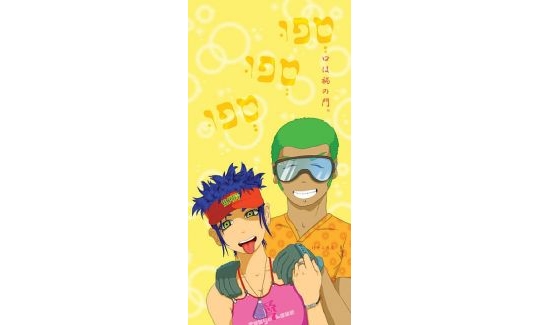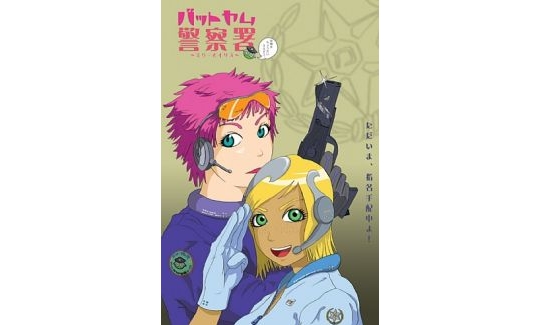The Japanese artist Tsuchida Eliya was born in Tokyo in 1974. Unlike the many Japanese who regularly read manga (comics) during their childhood and youth, Tsuchida never showed any interest in them. From a very early age he dreamed of becoming an artist, and excelled in his art classes. When he entered high school, he was hospitalized for an operation. Friends who came to visit him brought him manga books by Yoshida Senshe containing short comic strips of four frames - introduction, development, turning-point, and conclusion. What pleased Tsuchida most about these manga was Yoshida's ability to change stereotypical events into something wonderful and fantastic in such brief episodes.
Tsuchida decided to study art in order to realize his dream. He did not want to study in Europe or the United States, unlike many other Japanese students. Instead, since his father was a Christian of the Makuya sect, known for its empathy with Israel, he arrived here in 1998 in order to study at Bezalel.
In 2003 he returned to Japan, where he learned animation at the Academy of Art. In Japan he designed anime (animation) figures and manga for research & development companies specializing in computer games, including the Ganbarion Company, the second largest in this field. Tsuchida also designed the play-station images for Sony, presented in this exhibition. He came back to Israel one year later, and is known here essentially as a designer and illustrator who also teaches anime and manga.
For the current exhibition, Tsuchida decided to concentrate on subjects connected with Israel and Judaism, but in a futuristic mode. Thus, for example, he depicts a deji-kabe (digital wall), a futuristic Wailing Wall - a giant computer screen sensitive to touch. Instead of little notes thrust deep into the interstices between the stones, believers convey their pleas to the Almighty by writing directly on the screen with a digital pen. This manga tells the story of a little girl whose parents have abandoned her. Even though she is not religious, a friend counsels her to go to the digital wall and beg God for her parents' return. The little girl wonders about God's e-mail address, whether He uses the Internet Express, and how much He pays for His subscription. The manga "Shimi and Deli" is the story of Samson and Delilah, depicted in Tsuchida's manga as hairdressers in a trendy salon. Deli is jealous of Shimi because he attracts more clients, so she makes an awful mess of the haircut she gives him. In the end, however, it becomes apparent that Shimi, who is going bald, is wearing a wig that he got from a friend, and is worried about his friend's reaction to the barbered wig.
Tsuchida has also created posters for animated films for this exhibition, one of which is about the Flood. Unlike Noah in the Bible, the Noah of the future is getting ready to set sail, with the animals, in a very state-of-the-art space ship. In another episode, he depicts Haman with Esther who is interceding for the fate of the Jews.
The exhibition also shows us how Israelis are represented in Japanese comics. At a time when more women are being admitted into the Air Force, the poster "The best girls for pilots, the best pilots for girls" seems more relevant than ever. It shows a flight crew and an army unit, and behind them a pink fighter aircraft.
In manga and anime, hair is painted in all the colours of the rainbow, which helps to distinguish between characters. A focal male figure usually has black hair to distinguish him from others whose hair is of different colours. Figures with special powers usually have weirdly-coloured hair. Red hair can denote someone possessed by a spirit or ghost, or an arrogant, over-confident personality. Fair hair signifies intelligence and/or innocence. Pink hair is usually seen on girls and young women. This is a happy colour, equated with sweetness of character (kawai). Green symbolizes a good person who sometimes goes astray but ultimately returns to the right path. Blue hair can signify somebody shy, gentle, clever and funny, while grey hair signifies someone with hidden powers or great intelligence. White hair on a young person signifies honour and nobility.
Tsuchida Eliya insists that he simply likes hair of different colours, and that the colours do not have any specific connotations in his works apart, perhaps, from purple/pink. In the Japanese tradition, purple is associated with nobility and wisdom. "But today" says Tsuchida, "this is the colour preferred by carefree youngsters."
Tsuchida's style derives from illustrations for video games, in which his images are often more anatomically lifelike. Furthermore, the detail in his images is usually much more elaborate than in regular manga, which are usually standardized black-and-white line drawings. "Good" or "sensitive" figures are depicted with round eyes that are usually not as large as those in other manga and anime. "Wicked" people, like Haman, have narrow, blazing eyes.
Tsuchida is mainly influenced by the work of Renji Murata, who creates very human images for video games and animation. However, Murata uses more subdued colours than Tsuchida, whose recent works also show signs of the influence of Go Takeuchi, a synthesis of Japanese and western elements.



